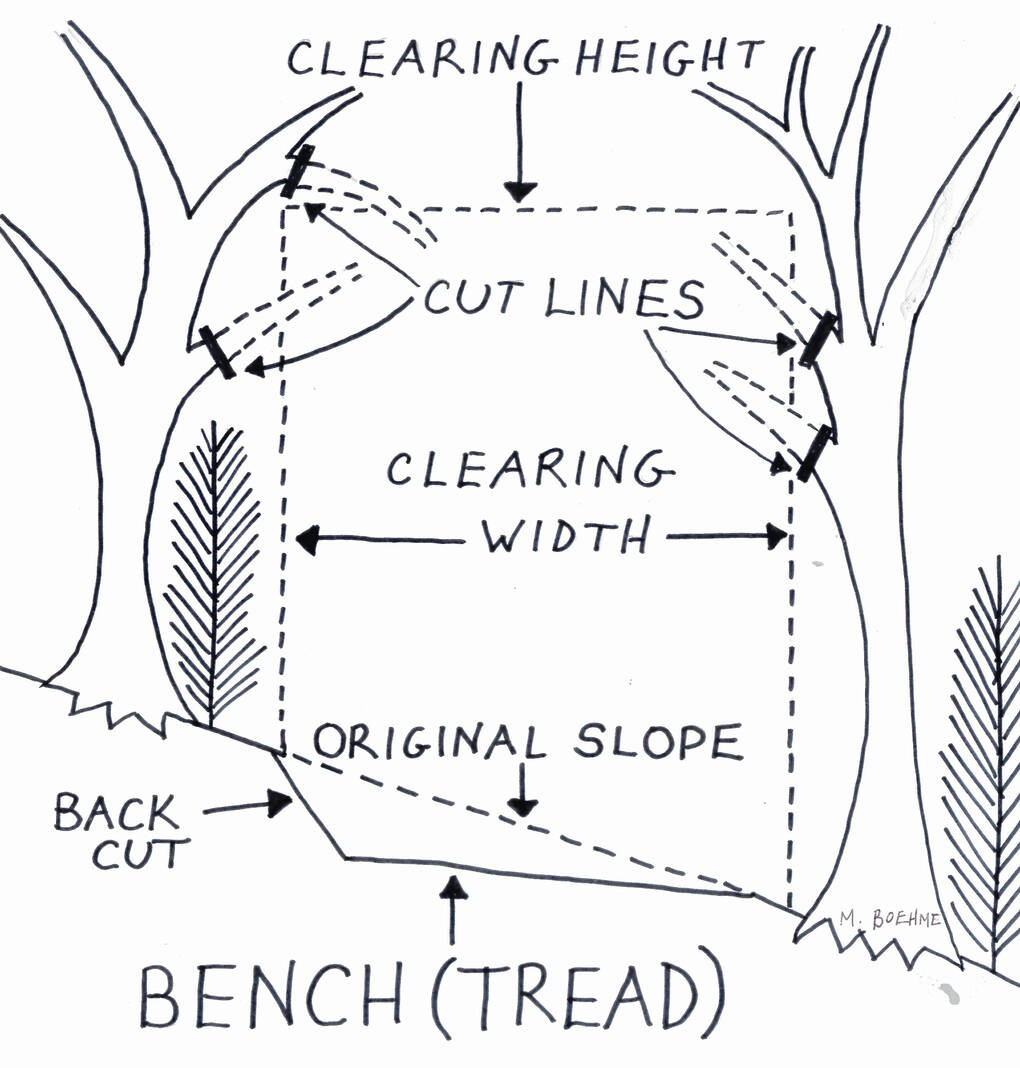

This drawing shows how a typical woodland trail is cleared and “benched.”
Illustration by Marjorie Boehme
Have you ever hiked the Appalachian Trail or one like it? One of the great pleasures is to enjoy a walk in the woods and fields without having to stumble through the brush or worry about what’s underfoot. You can move quietly through nature, enjoying the wildlife around you. Those of you with natural areas on your own property probably would enjoy it more if you had nice trails to walk on year round.
A good trail is wide enough for two people to walk side-by-side but not wide enough for ATV’s. There are no overhanging branches or stickers to grab you on the way past, and the treadway drains quickly when it rains so there’s no mud. The slopes are gentle, not more than a 10% grade to climb. It’s well marked so you won’t lose your way. Trails like this take some planning and hard work to create but good trails are easy to maintain once they’re in place.
Planning and building trails through your property may not be easy, but it’s a great investment that will bring years of pleasure. From painful experience we can offer plenty of tips on how, and how NOT, to build trails. A few pointers:
Trail design and building is easiest in late fall through early spring. You can see better, it’s cooler, and there are less insects.
Build trails along, not up and down, hills and slopes. Otherwise they’ll wash out or be too steep to walk comfortably. Ridgetop trails are best.
Trails through woods are easiest to maintain, and trails through open, sunny areas are hardest (believe it or not).
The more hard work and trouble you invest building your trail, the easier it will be to maintain so you can enjoy walking it.
“Benching” is the real work of trail building. Benching means cutting a shelf or treadway wide enough to walk on, along the sides of slopes. Every rock, stump and woody plant must be thoroughly dug out, and the ground leveled off, with just enough slope that water can drain off. We like to use a “cutter mattock” for this task, and follow up with a bow rake.
It’s tempting to save work by zig-zagging around trees and rocks, but sometimes the best route requires major work to dig out obstacles. Pick a route as straight and direct as possible, between the largest trees. We’ve cut down plenty of younger trees to clear trail, but there’s no shortage of trees in our woods so we don’t miss them.
Mudholes are no fun to hike through, so your bench must be carefully smoothed and sloped to eliminate low spots in the trail where puddles can form. You can use logs from the trees you cut, to get across gullies. Just lay them down crosswise in small washouts.
There’s more to trail planning, building and maintenance than we can explain in this short article, but if you are interested here’s how to find out more: Take a look at this website: http://traildesign.tripod.com/reference.htm or Google “trail building” for lots of resources on this topic.
We are very fortunate that our farm is along the Buckeye Trail, part of the North Country Trail system across the Midwest. North Country Trail volunteers built a one-mile “loop trail” on GoodSeed Farm, an investment of hundreds of man-hours. Watching the process of building “certified trail” was a real education for us, and we enjoy countless hours hiking on our own property. You can, too, since the North Country Trail is open to the public. For more information on the Buckeye Trail, check out www.buckeyetrail.org and www.northcountrytrail.org.
Steve Boehme is a landscape designer/installer specializing in landscape “makeovers”. “Let’s Grow” is published weekly; column archives are on the “Garden Advice” page at www.goodseedfarm.com. For more information is available at www.goodseedfarm.com or call GoodSeed Farm Landscapes at (937) 587-7021.

